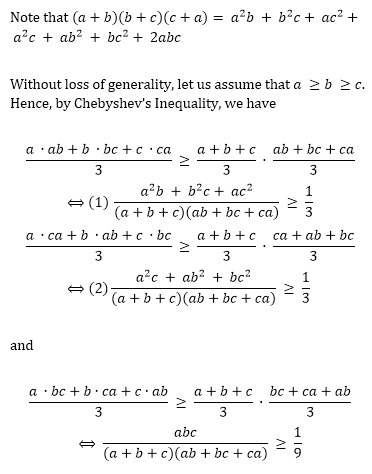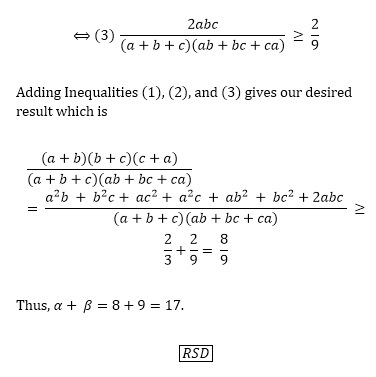Inequality
If a , b , c ≥ 0 , the maximum value of N which satisfies the inequality
( a + b + c ) ( a b + b c + c a ) ( a + b ) ( b + c ) ( c + a ) ≥ N
can be expressed in the form β α , where α and β are coprime, positive integers. Find the value of α + β .
The answer is 17.
This section requires Javascript.
You are seeing this because something didn't load right. We suggest you, (a) try
refreshing the page, (b) enabling javascript if it is disabled on your browser and,
finally, (c)
loading the
non-javascript version of this page
. We're sorry about the hassle.
4 solutions
Could you explain to me why if I put a = 1 , b = 2 and c = 3 the result is bigger?
Nice solution!
BTW, using AM-GM rule on each term is also giving the same answer. Can you explain why does that happen? It happens many times.
Log in to reply
I'm guessing that happens because the equality occurs when all the terms are equal. No idea how to prove it though...
Log in to reply
Hmm yeah! But it happens many times!!
Log in to reply
@Kartik Sharma – I'll post a solution soon. It makes use of the AM-GM Inequality.
The expression being symmetrical in a, b and c. In most of such cases, the equality always holds at a = b = c . So lets put a = b = c = k ( s o m e o t h e r c o n s t a n t ) . The value of the expression comes out to be 9 8
Log in to reply
That is not a proof. There are lots of counter examples to such a claim.
Log in to reply
Can you give a example please.
Let:
3 u = a + b + c
3 v 2 = a b + b c + a c
w 3 = a b c
By using the u ≤ v ≤ w method,
( a + b + c ) ( a b + b c + c a ) ( a + b ) ( b + c ) ( c + a )
= ( a + b + c ) ( a b + b c + c a ) ( a + b + c ) ( a b + b c + c a ) − a b c
= 1 − 9 u v 2 w 3
≥ 1 − 9 u 3 w 3
= 1 − 9 ( 3 a + b + c ) 3 a b c
≥ 1 − 9 a b c a b c (AM-GM)
= 9 8
The equality holds when a = b = c .
You don't need AM-GM in this solution, the uvw method implies uv^2 > w^3.
By AM-GM , we'll get (a+b)(b+c)(c+a) >= 8abc , (a+b+c) >= 3(abc)^(1/3) and (ab+bc+ca) >= 3(abc)^(2/3) so , 8abc/[(3(abc)^(1/3))(3(abc)^(2/3))] = 8/9 >= N so , a+b=8+9=17
Lakas neto!


( a + b ) ( b + c ) ( c + a ) = a b 2 + a 2 b + b 2 c + b c 2 + a c 2 + a 2 c + 2 a b c
And ( a + b + c ) ( a b + b c + c a ) = a b 2 + a 2 b + b 2 c + b c 2 + a c 2 + a 2 c + 3 a b c
So ( a + b + c ) ( a b + b c + c a ) ( a + b ) ( b + c ) ( c + a ) = a b 2 + a 2 b + b 2 c + b c 2 + a c 2 + a 2 c + 3 a b c a b 2 + a 2 b + b 2 c + b c 2 + a c 2 + a 2 c + 2 a b c
= 1 − a b 2 + a 2 b + b 2 c + b c 2 + a c 2 + a 2 c + 3 a b c a b c = 1 − ( a + b + c ) ( a b + b c + c a ) a b c
So, To find N , we have to find maximum of ( a + b + c ) ( a b + b c + c a ) a b c
WLOG, a ≥ b ≥ c ⟹ b c ≤ c a ≤ a b .
Therefore by Chebyshev's Inequality,
( a + b + c ) ( b c + c a + a b ) ≥ 3 ( a b c + a b c + a b c )
( a + b + c ) ( b c + c a + a b ) ≥ 9 ( a b c )
9 1 ≥ ( a + b + c ) ( b c + c a + a b ) a b c .
Therefore, N = 1 − 9 1 = 9 8